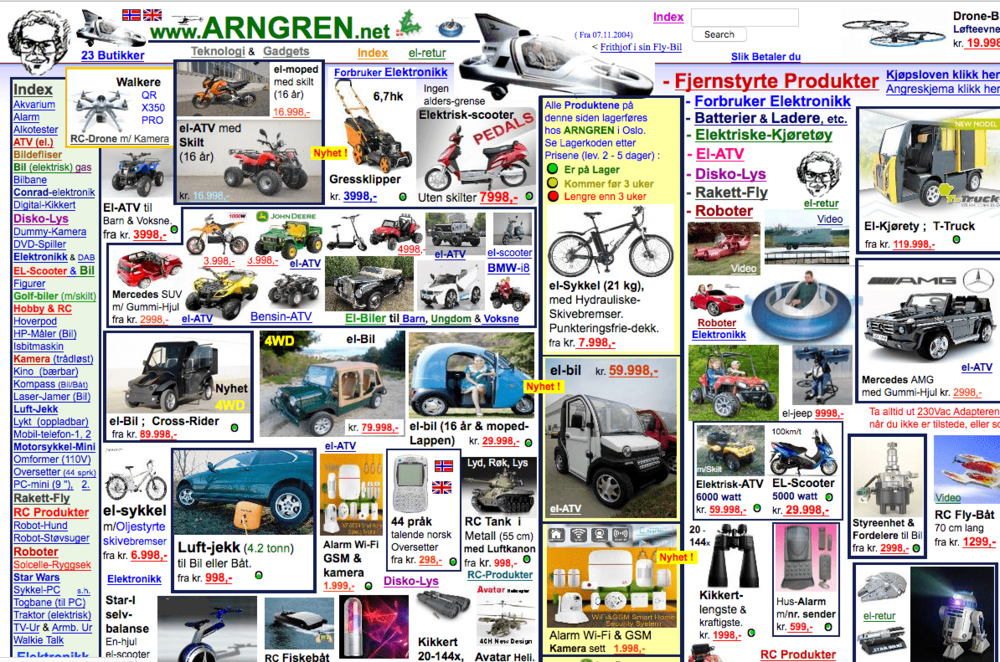July 24, 2016
Purge Content in 5 Easy Steps (And Why You Should)
Yes, content is still king, but being a content hoarder can actually hurt you — especially if you are going through the process of a website migration. Find out what content baggage looks like and how you can repurpose it, reorganize it, or just dump it.
While you’re busy deciding what to put on your site, you may be overlooking the things you should take off. By removing low quality, outdated or irrelevant content from your site, you can increase user engagement and improve your relationship with Google.
Follow these 5 steps to determine what you should remove from your site and why.
1. Start With a Content Inventory
In most cases, a content inventory (CI) is the first step in the discovery phase of a web project. Whether you’re redesigning, refreshing or migrating a site, content inventories help you:
- see the size and scope of a site
- sort and classify types of content
- understand if content is properly located
- determine if content is up-to-date
Getting started on a content inventory is easy when you use an automated app to “scrub” your site. Automated content analysis tools quickly retrieve pages, images, and other files from your site so you can see the entire guts of your hosted domain in a single spreadsheet. While software can’t replace human eyes for determining the value of content, they’re a great power tool to get you started on your content analysis.
Which Content Inventory Tool Is Best?
There are a number of automation tools on the web for creating content inventories. Simply search “content inventory tool” and you’ll see a host of options. Inventory tools vary in what they capture. For determining what content you want to purge, most content inventory tools will do the trick. Look for a tool that has the following information for each piece of your site’s content:
- Unique content ID
- Title
- URL
- File format
- Location
- Categories / tags
- Dates
Be careful when using free software, as free services may only capture a limited amount of pages or data. While you can find a free service to get the job done, may want to subscribe to or purchase the software to get full functionality. The final document should be a spreadsheet or data such as XML that you can import into a spreadsheet. This spreadsheet is what you will use to audit your content.
2. Categorize Your Content by “Type”
Now that you have the content inventory, it’s time to start a content audit. Begin by taking a look at the types of content you have listed based on the URL or page title. If you don’t already have one, create a row called “Content Type.”
Scroll through each URL and classify your content into types. This may be filled in already from the content inventory tool, but you probably want to reword things to meet your needs. Your various content types may look something like this:
- Blog post
- Landing page
- Form
- File (PDFs or other documents)
- Event
- Image
For now, we strictly want to see a broad category of types of content. (later in your content audit, you can dig deeper by sorting various topics and subject matter.) Defining the kind of content you have on your site helps you see the big picture. Finally, when you have every line of content in a category, sort it in ascending order so all types of content are grouped together. This makes things easier to see.
3. Look At Your Content
Now we get to the nitty gritty of looking at your content. Yes, in order to do a proper evaluation, you need to go through each row and look at each piece of content individually. Open the URL to see the pdf files, web pages, media, blog posts, and everything else that is currently living on your site. Especially take a look at anything you don’t recognize or are unsure about listed in the content inventory.
You may be surprised at what you find when you click those links. Published blog posts that are blank, HTML text with the default “lorem ipsum” copy, and 20 instances of the same page with different URLs are all examples of content that needs to be removed from your site.
Perform a Content Analysis
Now that you know exactly what’s on your site, you need to see what content is important to other people. Spend some time in Google Analytics or Crazy Egg (two tools that our team uses often here at Digital Services Georgia) and see what the results are for the past year. As a general rule, if content hasn’t been accessed in over a year, it’s probably safe to get rid of.
4. Identify Unwanted Content
As you scroll down the content inventory, checking links, and putting eyes on your published material, you’ll need to identify content that is purge-worthy or at the very least, questionable. Highlight these rows in the inventory so you can easily recognize them and make a note of why you highlighted it.
What is Unwanted Content?
Those in the digital biz refer to unwanted content using the acronym ROT (Redundant, Outdated, and Trivial.) ROT is a huge problem on large websites.
Redundant Content
Redundant content includes products or services that no longer exist, repetitive information that could easily be consolidated into one page or duplicate content with different page titles or headers. Redundant content is usually easy to spot and is a no-brainer when deciding to remove it.
Out-of-Date Content
No one is looking at your press releases from 2003. And if they are PDF files, they are definitely taking up too much bandwidth. Don’t use your server as a keepsake to archive old stuff. Keep in mind that content has a limited shelf life. Past events, news releases from years ago and old images need to be ditched from time to time.
Low Quality Content (Trivial)
Content that has little value to your audience is low quality. Ask yourself: “Is this something my audience engages with or is it something that will be ignored?”
Ultimately, as a subject matter expert, you are the best judge when it comes to the needs of your visitors. However, we can’t ignore the other judge, Google.
Google gives priority to sites that are written by experts and also offer the best user experience. E-A-T is the acronym Google uses for Expertise, Authority, and Trustworthiness, and it’s what Google looks for in high-quality content. If you’d like to learn more about how Google rates high-quality content, take a look at Google’s Search Quality Evaluator Guidelines.
Irrelevant Content
If you manage a government agency site that informs people about climate change, it may seem obvious that you’re not going to post blog articles about food recipes or fitness tips. However, be careful not to let irrelevant content sneak up on you. Useless information and unrelated links can devalue your content, brand, and purpose.
5. Remove Unwanted Content
If you don’t use it, lose it!
Why Should You Remove Content?
Content consolidation and removal allows you to take a closer look at your content strategy. The more you streamline your content with your overall strategic goals, the more users can interact with your site the way you intended.
Reduce Maintenance Cost
Sure, digital information is super cheap and even free to post on your site. But there are hidden costs of keeping content you don’t need. Those old graphics, irrelevant excel files, and countless newsletters from 2009 are taking up valuable bandwidth. If you have a lot of old content, it could even be slowing you down.
Improve Usability
Have you ever been in someone’s kitchen who didn’t like to throw things away? Countertops are cluttered with anything that enters through the back door. The dining table is buried underneath stacks of paper and other random stuff. You don’t know how to navigate to get what you need and you don’t dare open that fridge. Clear the clutter and invite users to access what they came for. Purging old content can streamline your user experience.

Promote Digital Evolution
Your site will evolve with the products and services you offer. Ideally, it will evolve with the latest web technology too. Holding on to those old PDF forms that users have to sign and fax is holding you back from taking advantage of the latest digital capabilities. Users adapt very quickly to new information and practices. If you’re hoarding old content, you could be at risk of getting stuck in your ways — unable to see the big, evolving picture.
How do you remove content?
Purging content can be daunting, but it’s not so scary after you commit to the process. Once you identify what content your site can do without, there are a few ways you can dump it.
Start From Scratch (Content Migration)
If you are about to begin a content migration, lucky you! This is a perfect opportunity to do a complete content overhaul because you only need to import the content that matters most. Go over the content inventory provided by your project manager. The content strategist may have already made some suggestions based on findings — including a restructure of your navigation or IA (Information Architecture.)
Establish a Content Review Policy
Even if you are not undergoing a large project such a site refresh or migration, it’s a good idea to establish a content review policy on a regular basis. For agencies that have more than one content contributor, this is especially important. The content review policy should establish a way for content managers to review and update content periodically. Finding content that is redundant, broken or inconsistent in voice or tone is an ongoing job.
Combine Content
Maybe you have come across more than one page that is “thin” with too little information. In some cases, you may be able to combine content and make a new post or page that offers more relevant value. For example, if you have one page with a few helpful resource links but no copy, find a relevant page and combine it where it’s most useful. Then, you can delete the page with the few links once you copy the content.
Simply Delete
If you’re unsure or skittish about pushing the “delete” button, copy and paste the content into a Word doc and save it on your hard drive or backup drive on your computer. If you have old blog posts or press releases but you feel you must have them available to the public, create an archive folder on your site. Let people search the archives if they want as long as they know it’s older content.
Purging content from your site can be a healthy step toward maintaining quality and updated information. If content has the seeds of being something valuable, you can work with it — update it, recycle it or merge it with more relevant content. But if you have old newsletters, past event pages or other information people don’t care about, don’t be scared to trash it. Of course, you can always ask the DSGa team if you have any questions about cleaning out your content.
